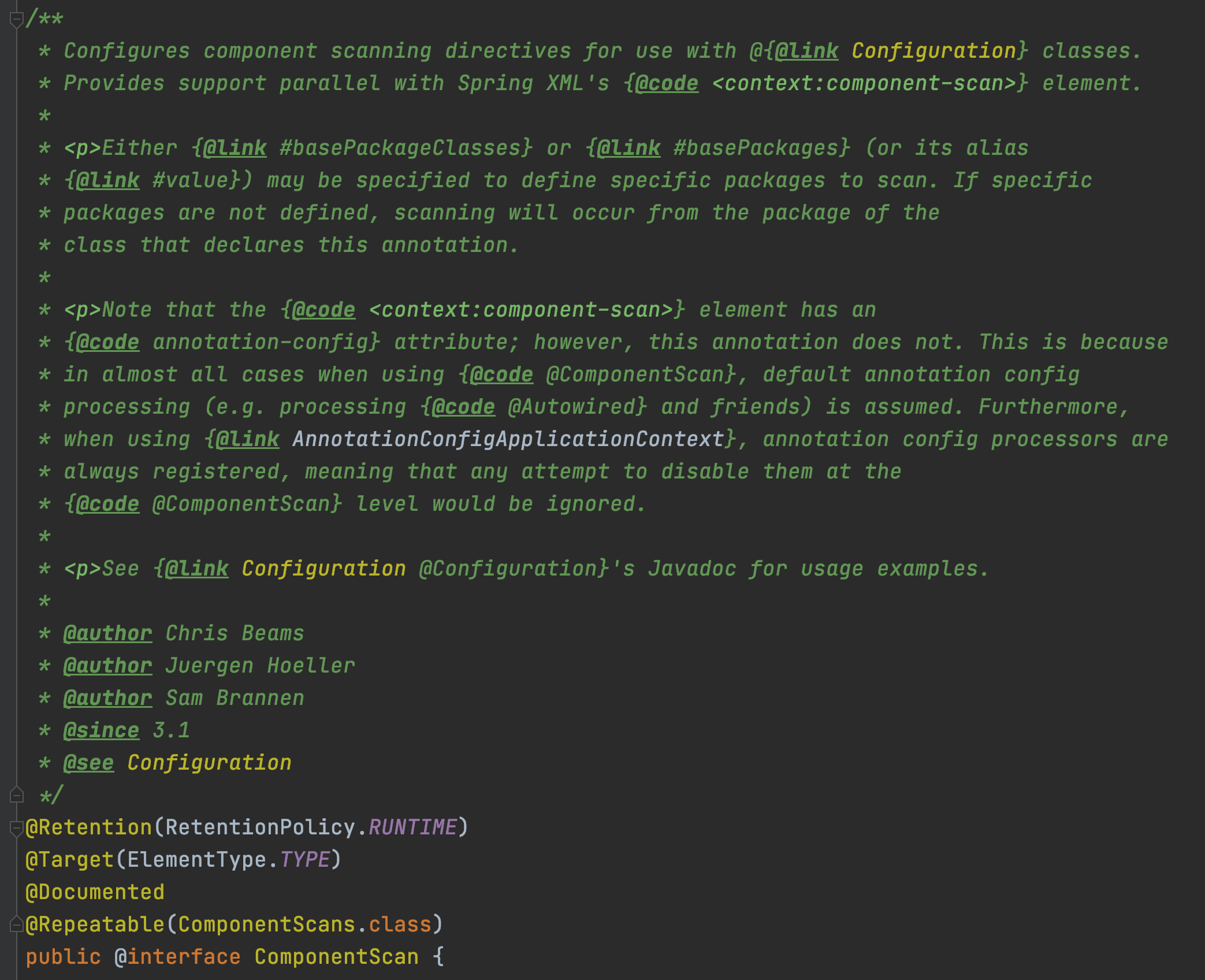原创转载请注明出处:https://www.cnblogs.com/agilestyle/p/14902155.html
原理
@SpringBootApplication 是一个复合注解,包括
- @SpringBootConfiguration
- @EnableAutoConfiguration
- @ComponentScan

Note:
@ComponentScan(excludeFilters = { @Filter(type = FilterType.CUSTOM, classes = TypeExcludeFilter.class),
@Filter(type = FilterType.CUSTOM, classes = AutoConfigurationExcludeFilter.class) })
- excludeFilters:Specifies which types are not eligible for component scanning
- @Filter:Filter annotation
- FilterType.CUSTOM:Filter candidates using a given custom implementation
- classes:Filter specific class, include TypeExcludeFilter, AutoConfigurationExcludeFilter
@ComponentScan 源码

Note:
- 通常自定义一个Spring Bean,一般在类上加上注解 @Component、@Service、@Controller,定义好后,需要使用@ComponentScan 来告诉Spring IoC 容器去哪里装载自定义的Spring Bean
- @SpringBootApplication 包含了@ComponentScan,所以@SpringBootApplication注解所在包及其子包目录下的Spring Bean都会被扫描并装载到Spring IoC容器。
- 如果自定义的一个Spring Bean,不在@SpringBootApplication 注解所在包及其子包目录下,需要手动加上@ComponentScan 注解并指定自定义Spring Bean所在的包。
示例
Project Directory

Maven Dependency

<?xml version="1.0" encoding="UTF-8"?> <project xmlns="http://maven.apache.org/POM/4.0.0" xmlns:xsi="http://www.w3.org/2001/XMLSchema-instance" xsi:schemaLocation="http://maven.apache.org/POM/4.0.0 http://maven.apache.org/xsd/maven-4.0.0.xsd"> <modelVersion>4.0.0</modelVersion> <parent> <groupId>org.springframework.boot</groupId> <artifactId>spring-boot-starter-parent</artifactId> <version>2.3.12.RELEASE</version> <relativePath/> </parent> <groupId>org.fool</groupId> <artifactId>hellospring</artifactId> <version>1.0-SNAPSHOT</version> <properties> <maven.compiler.source>8</maven.compiler.source> <maven.compiler.target>8</maven.compiler.target> </properties> <dependencies> <dependency> <groupId>org.springframework.boot</groupId> <artifactId>spring-boot-starter-web</artifactId> </dependency> </dependencies> <build> <plugins> <plugin> <groupId>org.springframework.boot</groupId> <artifactId>spring-boot-maven-plugin</artifactId> </plugin> </plugins> </build> </project>
SRC
MockComponentScan.java
package org.fool.spring.component.scan; import org.springframework.stereotype.Service; @Service public class MockComponentScan { public MockComponentScan() { System.out.println("MockComponentScan init..."); } @Override public String toString() { return "MockComponentScan{}"; } }
MainTest.java
package org.fool.spring.component.core; import org.fool.spring.component.scan.MockComponentScan; import org.springframework.boot.SpringApplication; import org.springframework.boot.autoconfigure.SpringBootApplication; import org.springframework.context.ConfigurableApplicationContext; import org.springframework.context.annotation.ComponentScan; @SpringBootApplication @ComponentScan("org.fool.spring.component.scan") public class MainTest { public static void main(String[] args) { ConfigurableApplicationContext context = SpringApplication.run(MainTest.class, args); MockComponentScan bean = context.getBean(MockComponentScan.class); System.out.println(bean); } }
Note: MockComponentScan.java 和 打上@SpringBootApplication 注解的MainTest.java 不在同一个包中
@ComponentScan("org.fool.spring.component.scan")
Run

反之如果将 @ComponentScan 注释掉

再次运行MainTest.java,会抛出异常
Exception in thread "main" org.springframework.beans.factory.NoSuchBeanDefinitionException: No qualifying bean of type 'org.fool.spring.component.scan.MockComponentScan' available at org.springframework.beans.factory.support.DefaultListableBeanFactory.getBean(DefaultListableBeanFactory.java:351) at org.springframework.beans.factory.support.DefaultListableBeanFactory.getBean(DefaultListableBeanFactory.java:342) at org.springframework.context.support.AbstractApplicationContext.getBean(AbstractApplicationContext.java:1127) at org.fool.spring.component.core.MainTest.main(MainTest.java:14)

欢迎点赞关注和收藏

